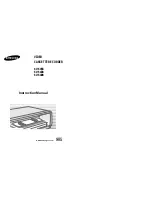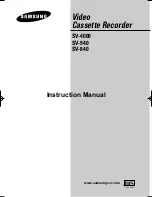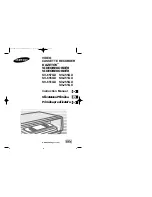
GRUNDIG Service
2 - 21
GV 54…, GV 56 …, SE 5106…
Beschreibungen / Descriptions
7. Keyboard Control Units (ODCG / DC)
Function Overview
The Keyboard Control Units consist of the following function groups:
Keyboard Control Unit I:
– 8-Bit-Single-Chip Microcomputer (IC7120)
– Vacuum Fluorescent Display (VFD)
– IR-Receiver and Remote Control Evaluation
– Keyboard
– Pulse Processing for Jog and Shuttle
– SYNCHRO-EDIT Socket
– Input Sockets for VIDEO, LINE, Microphone
– Microphone Input Amplifier
– Output Socket for Headphones
Keyboard Control Unit II:
– Keyboard (keyboard matrix)
– Jog/Shuttle
7.1 8-Bit-Single-Chip Microcomputer (IC7120)
The mask-programmed 8bit-microcomputer (IC7120) on the Key-
board Control Unit I works as a slave computer. The 8MHz clock
frequency is determined by means of quartz Q1120. This keyboard
control computer IC7120 evaluates the commands entered on the
keyboard and the Jog-Shuttle commands, decodes the commands
from the infra-red remote control handset and drives the display (VFD)
and the LEDs respectively.
Communication with the central computer of the sequence control on
Family Board (IC7300) is effected serially in two directions at TTL-level
on a modified three-lead I
2
C-bus. These three leads are: SCL (P36),
SDA (P54) and INT (P11/INT1). The data transferred on the SCL and
SDA are standard I
2
C-bus signals. The trailing edge of the INT signal
permits multimaster-I
2
C-bus-communication in high-speed mode be-
tween the central processing unit and the keyboard control computer.
The keyboard control computer can be reset by a LOW level at the DC-
RESET lead.
7.2 Display (VFD) Drive
In principle, the display is a directly heated triode valve. The filaments
of the tube are used at the same time as the cathode. The display
heater is supplied with an AC voltage at the terminals F1 and F2. For
this a transformer 5082 is provided in the power supply unit the primary
side of which is pulsed at 62.5kHz by the keyboard control computer
IC7120-(80), T7258 (Family Board – Sequence Control) and the
switching transistor T7080. The secondary AC voltage (
F1 /
F2)
is approx. 5.4V
rms
and is clampeld to approx. -21V by means of the Z-
diode D6135, R3133 and R3135. In "Low-Power/Standby" mode the
drive to the transistor 5082 (LOW level at Pin 80 of IC7120) is stopped
so that no voltage is supplied to the display heater.
The symbols of the display illuminate only if the electrons emitted from
the cathode and accelerated by the grid strike the fluorescent layer of
the anode (symbols).
The 15 grids (display contacts 37…51) are driven by IC7120 via the
ports P61…P67 / P70…P77, and the 16 anodes (display contacts
5…20) via the ports P80…P87 / P90…P97. The display drive is carried
out in time multiplex mode at a duty factor of 1:16, a grid scanning
period of T
P
= 2.048ms (16 x 128
µ
s) and a voltage deviation of +5V /
-28V.
A display element illuminates only if the respective anode and its
surrounding grid are switched to +5V at the same time for a certain
period during a scanning period. During the time the anodes and grids
are not driven within the scanning period the grids are connected to
approx. -28V via internal pull-down resistors of the
µ
C IC7120.
7.3 IR-Receiver and Remote Control Evaluation
The integrated circuit IC7105 is a selective, gain-controlled amplifier
with an integrated photo-diode. The IR-Receiver converts the received
infra-red light (940nm) to electrical pulses which are then amplified and
demodulated. On the Interrupt input port INT3 of the IC7120 the output
signal from the IR-Receiver (IC7105) is read into the microcomputer as
a pulse sequence at TTL level (0V / 5V) for further processing and bit
decoding.
7.4 Keyboard (keyboard matrix)
The Keyboard Control Units I/II are fitted with a maximum of 15 buttons.
The status of the 5 buttons 24…28 on Keyboard Control Unit I is
detected by a voltage divider R3070…R3074 and this information is
sent to the analog input CIN0 of the keyboard control computer. When
no button is pressed, the voltage at CIN0 is 0V. When pressing the
buttons the following voltages are supplied correspondingly:
T24: 5V
T25: 4V
T26: 3V
T27: 1.9V
T28: 0.9V
7. Bedieneinheiten (ODCG / DC)
Funktionsübersicht
Die Bedieneinheiten bestehen aus folgenden Funktionsgruppen:
Bedieneinheit I:
– 8-Bit-Single-Chip Microcomputer (IC7120)
– Vakuum-Fluoreszenz-Display (VFD)
– IR-Empfänger und Fernbedienauswertung
– Bedienfeld
– Impulsaufbereitung für Jog und Shuttle
– SYNCHRO-EDIT-Buchse
– Eingangsbuchsen für VIDEO, LINE, Mikrofon
– Mikrofoneingangsverstärker
– Ausgangsbuchse für Kopfhörer
Bedieneinheit II:
– Bedienfeld (Tastatur-Matrix)
– Jog/Shuttle
7.1 8-Bit-Single-Chip Microcomputer (IC7120)
Der maskenprogrammierte 8Bit-Microcomputer (IC7120) auf der Be-
dieneinheit I arbeitet als Sub-Rechner. Die Taktfrequenz 8MHz ist mit
dem Quarz Q1120 festgelegt. Dieser Bedienrechner IC7120 wertet die
eingegebenen Befehle der Tastatur und des Jog-Shuttle aus, deko-
diert die Befehle der Infrarot-Fernbedienung und steuert das Display
(VFD) bzw. die LEDs an.
Die Kommunikation mit dem Hauptrechner der Ablaufsteuerung auf
der Chassisplatte (IC7300) erfolgt seriell und bidirektional mit TTL-
Pegel über einen modifizierten Dreileitungs-I
2
C-Bus mit den Leitungen
SCL (P36), SDA (P54) und INT (P11/INT1). Bei SCL und SDA handelt
es sich um Standard-I
2
C-Bus-Signale. Mit der fallenden Flanke des
INT-Signales wird eine Multimaster-I
2
C-Bus-Kommunikation im High-
Speed-Mode zwischen Hauptrechner und Bedienrechner ermöglicht.
Der Bedienrechner ist mit einem LOW-Pegel auf der Leitung DC-
RESET rücksetzbar.
7.2 Ansteuerung des Displays (VFD)
Das Display ist im Prinzip eine direkt geheizte Röhrentriode. Die
Heizfäden der Röhre dienen gleichzeitig als Kathode. Die Display-
Heizung wird über die Anschlüsse F1 und F2 mit Wechselspannung
versorgt. Hierfür ist ein Transformator 5082 im Netzteil, der primärseitig
vom Bedienrechner IC7120-(80), T7258 (Chassisplatte – Ablauf-
steuerung) und dem Schalttransistor T7080 mit 62,5kHz getaktet wird.
Die sekundärseitige Wechselspannung (
F1 /
F2) beträgt ca.
5,4V
eff
und ist mit der Z-Diode D6135, R3133 und R3135 auf ca. -21V
geklemmt. Im "Low-Power/Standby"-Modus erfolgt keine Ansteue-
rung des Trafos 5082 (LOW-Pegel an Pin 80 des IC7120) und der
Heizstrom für das Display bleibt aus.
Die Symbole des Displays leuchten nur, wenn die von der Kathode
emittierten und vom Gitter beschleunigten Elektronen auf die Leucht-
schicht der Anode (Symbole) treffen.
Die Ansteuerung der 15 Gitter (Display-Kontakte 37…51) erfolgt vom
IC7120 über die Ports P61…P67 / P70…P77 und die der 16 Anoden
(Display-Kontakte 5…20) über die Ports P80…P87 / P90…P97. Diese
Display-Ansteuerung erfolgt im Zeit-Multiplex-Verfahren mit einem
Duty-Faktor von 1:16, einer Gitter-Scanning-Periode von T
P
= 2,048ms
(16 x 128
µ
s) und einem Spannungshub von +5V / -28V.
Ein Display-Element leuchtet nur, wenn innerhalb einer Scanning-
Periode gleichzeitig für eine bestimmte Zeitdauer die entsprechende
Anode und das sie umgebende Gitter auf +5V geschaltet werden. In
der "steuerungslosen" Zeit, während einer Scanning-Periode, liegen
die Gitter über interne Pull-down-Widerstände des
µ
Cs IC7120 auf ca.
-28V.
7.3 IR-Empfänger und Fernbedienauswertung
Bei IC7105 handelt es sich um einen selektiven, geregelten Verstärker
mit integrierter Fotodiode. Der IR-Empfänger wandelt das empfange-
ne Licht (940nm) in elektrische Impulse um. Diese werden anschlie-
ßend verstärkt und demoduliert. Am Interrupt-Eingangsport INT3 des
IC7120 wird das Ausgangssignal des IR-Empfängers (IC7105) als
Impulsfolge mit TTL-Pegel (0V / 5V) in den Mikrocomputer zur weite-
ren Verarbeitung und Bit-Dekodierung eingelesen.
7.4 Bedienfeld
Auf den Bedieneinheiten I / II sind maximal 15 Tasten zur Bedienung.
Der Zustand der 5 Tasten 24…28 der Bedieneinheit I wird mit dem
Spannungsteiler R3070…R3074 ermittelt und dem Analog-Eingang
CIN0 des Bedienrechners zugeführt. An CIN0 stellen sich im Ruhezu-
stand 0V und bei Tastenbetätigung folgende Gleichspannungen ein:
T24: 5V
T25: 4V
T26: 3V
T27: 1,9V
T28: 0,9V
















































